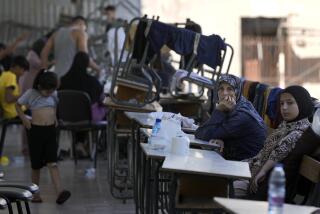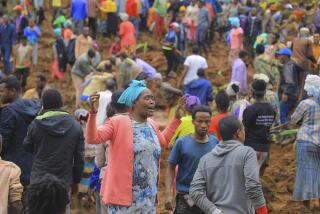Famine Lingers : Ethiopia Rain Can’t Wash Misery Away
IBNET, Ethiopia — The dark, heavy clouds move in from the east, through the mountain passes, and they build with every roll of thunder and crack of lightning.
In the valley, the crows take wing and the shrubs sway as the murmur of wind becomes a howl. Then the rain comes with a rush, sweeping down the foothills in torrents that pound the hospital tents and turn the valley into a river of mud.
Relief workers struggle to move famine-weakened patients off their soaked mattresses, to dig channels that will divert the water around the tents, to cover their stocks of maize. The sick and the hungry are quiet and obedient. Those who have the strength help doctors and nurses move the others to dry tents.
Downpour Welcome
However great the discomfort, the daily downpour is welcome, for the Ethiopian drought is over; the rains have returned to this parched land. Still, the famine that claimed 300,000 lives last year and created 150,000 orphans continues, as does the suffering.
Relief specialists say Ethiopia will be an international ward through 1986--the country will need half a million tons of grain next year under the best weather conditions--and maybe longer. Given that bleak forecast, most Western agencies are taking steps to shift their emphasis from relief to rehabilitation. In the process, they are quietly asking what political impact the disaster will have on this Marxist country.
“The political realities of the famine are complex,” Father Jack Finucane of Concern, an Irish humanitarian agency, said the other day. “The government here is Communist--military--and controls the biggest army in black Africa. Its obvious priority is to stay in power. All this affects everything that is happening here. People involved with the relief effort say, ‘Just leave politics out of it,’ but that’s naive. Politics can’t be left out of what’s happening here.”
Although virtually all the famine assistance has come from the West--the U.S. government is the largest donor, with contributions expected to reach $300 million this year--the disaster does not appear to have affected Ethiopia’s close relationship with Moscow, or to have forced Addis Ababa to re-examine its Marxist policies.
The Soviets seem content to let the West provide the money and food needed to help stabilize Ethiopia. In the long run, they could be the beneficiaries, at no cost. And Ethiopia’s ruler, Lt. Col. Mengistu Haile Mariam, has said nothing to indicate that he is disenchanted with the Soviet Union, on whom he counts for guns and ideology, not food or money.
Mengistu and the Western governments are mutually distrustful and hostile. Mengistu has grudgingly come to accept the fact that all the Western money pouring into Ethiopia gives the West a certain leverage, but Western diplomats do not believe leverage will nudge him or Ethiopia out of the Soviet orbit. As things now stand, they say, he is getting what he wants from both East and West.
Many Western relief specialists are openly critical of the Mengistu regime. They say the famine was as much a man-made crisis as a natural disaster. They note that Ethiopia is a fertile land that has always suffered from periodic drought, but that drought need not cause famine.
They point out that severe drought struck southern Wallo province in 1946-47 but that the farmers continued to harvest their crops. The most recent drought was different, for the government had spent all its hard currency for guns to stay in power and to fight various rebel movements throughout the country. When the rains failed, the government had no financial margin and no choice but to turn to the international community for help.
The government also had done little, according to agricultural experts, to control overgrazing, the burning of wood to make charcoal, and other misuses of the land. In the last 20 years, Ethiopia’s forest cover has been reduced from 16% to 4% of the total land area, resulting in excessive erosion that has turned many fertile areas into semi-desert.
As the land became arid and unproductive, farmers sold their primitive tools to buy water from neighbors who had wells. Then some well owners began filling others’ wells with rocks to drive up the price of water. The farmers were left with neither tools nor water, and in many cases these are the people who are now starving and dependent upon 250 feeding centers set up by Western agencies.
Conditions at the camps have improved in the last six months, and the death rate has dropped dramatically. But malnutrition and communal diseases--among them cholera, which the government insists on calling “severe diarrhea”--remain serious problems.
Here at Ibnet, 250 miles north-northwest of Addis Ababa, the capital, an outbreak of cholera was quickly arrested last month when Western health workers persuaded local authorities to close a polluted well and to put guards on it to prevent its use by peasants who did not understand the dangers of dirty water.
“This little boy weighed 22 pounds when he came in two weeks ago,” said a Ghanaian nurse, Esther Manieson, as she examined 11-year-old Fisum Ferdu. “But look. He’s gaining weight now. He’s getting his strength back. He’s going to make it.”
Literally hundreds of thousands of Ethiopians such as Ferdu have been saved by the international relief effort, which at Ibnet is run by Concern, World Vision International and the International Red Cross.
But U.N. officials say that at least 7 million Ethiopians are still hungry, and one has only to visit a camp like Ibnet to be overwhelmed by the bleakness of the Ethiopians’ lives and to realize how desperate the needs are in this impoverished country, where 20 of every 1,000 pregnant women die in childbirth and life expectancy at birth is only 44 years.
The families who wander to Ibnet from their mountain villages are dressed in earth-colored rags and grain sacks. Some are borne by relatives on homemade wooden stretchers and, wrapped head to toe in dirty clothes, they seem at first glance to be as lifeless as corpses. The limbs of many children are hardly bigger than twigs, and almost all the adults wear a dazed expression. Any Westerner who walks through their ranks is assumed to be a doctor and is besieged by requests for help.
Among the Western relief specialists working throughout Ethiopia, there is not the slightest doubt that another drought will one day strike this nation of 42 million. The question is whether it will have the same calamitous result as the drought of 1984-85. And that, they say, depends to a large degree on what priorities the government establishes.
“The prime issue now is the allocation of Ethiopia’s physical resources by the government,” said John McMullin, a developmental expert with World Vision. “Historically, it hasn’t invested in conservation measures, but I think we are beginning to see the first halting steps in that direction.”
With international help, terraces are being built on hilly farmland to stop the runoff of rainwater. Several agencies are providing survival kits--tools, rations and seed--to encourage families to leave the feeding centers when they are strong enough and return to their farms. Plans are being carried out to plant trees, including the fast-growing eucalyptus, in the deforested areas.
Scientists at the International Lifestock Center for Africa here are studying data provided by weather satellites to learn how they can more accurately forecast weather patterns--and thus increase harvests.
“The underlying trends in Africa are bloody awful,” said Peter Brunby, an Australian biologist who is the center’s director. “On a per capita basis, food production in Africa decreased 25% between 1961 and 1984. And between 1980 and 1984, population increased 15%.
“This drought was devastating simply because there hasn’t been any increase in the food output per acre. But we’re not talking about a basket case, in Ethiopia or in Africa as a whole. The opportunities for increasing food production in Africa are enormous. There is a tremendous opportunity to effect change.”
The Ethiopian government’s top priority to rehabilitate the land is to move 1.5 million Ethiopians from the famine areas to resettlement villages with good soil and ample rainfall. The plan has met with resistance from the West, especially the United States, which fears the relocation will be arbitrary and involuntary and will be used primarily to clear rebel sympathizers from anti-government regions.
Westerners do not quarrel, however, with the government’s contention that the feeding centers create a dependence and a welfare mentality that are detrimental to rehabilitation.
To avoid this kind of dependency, the 50,000 inhabitants of Ibnet were told by government soldiers in April to return to their villages to capitalize on the rains and prepare the ground for the fall harvest.
Then, after they had moved up into the hills, the soldiers burned down their straw huts. But within two days the peasants had returned to Ibnet, drawn by free food and medical attention, and had started to rebuild their makeshift village.
An international outcry over the soldiers’ harshness in carrying out the government order led to a public apology of sorts by Mengistu, indicating that no more refugee centers will be torched.
Thus far, about 400,000 Ethiopians have been transported in Soviet and Libyan planes and in government trucks to resettlement areas out of the drought regions. The government’s Relief and Rehabilitation Commission gives each family a month’s ration of food, as well as an “agpack,” containing a hoe, fertilizer, pesticide and 82 pounds of various seeds. An apparent effort has been made to keep families together.
Some former skeptics believe resettlement is the only sensible alternative open to the government.
“I’m in favor of it now,” said Brother Augustine O’Keefe of the Christian Relief and Development Assn. “When you look at the need, I don’t think there is any hope that the land in the drought areas can support its present population.
“At least there is hope that the people will become self-sufficient in their new homes. The big problem now is that many of the major donors are not prepared to give assistance to resettlement. But if the people were left where they are, they’d get relief, so it doesn’t make much sense not to help them in an area where they have a better chance of making it.”
More to Read
Sign up for Essential California
The most important California stories and recommendations in your inbox every morning.
You may occasionally receive promotional content from the Los Angeles Times.










